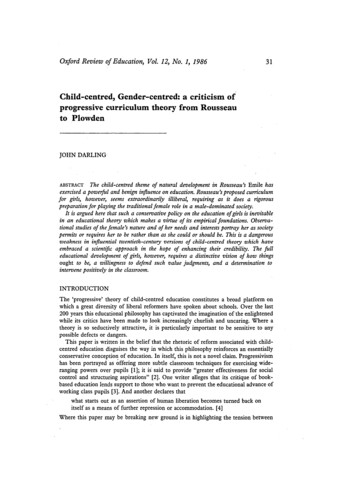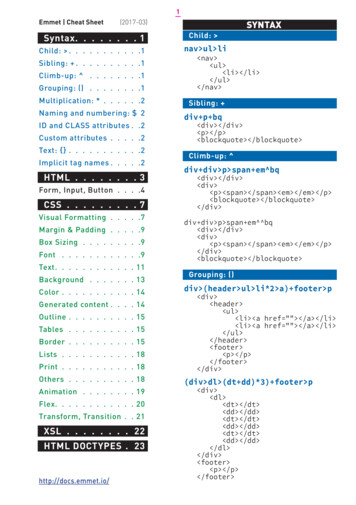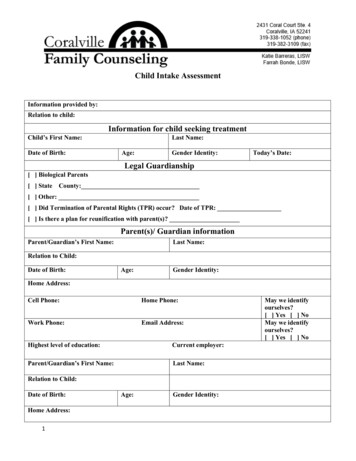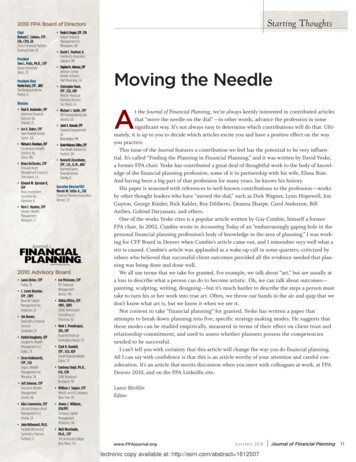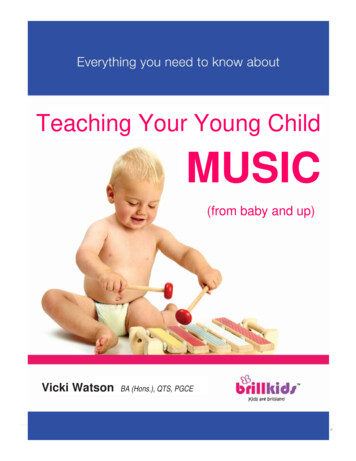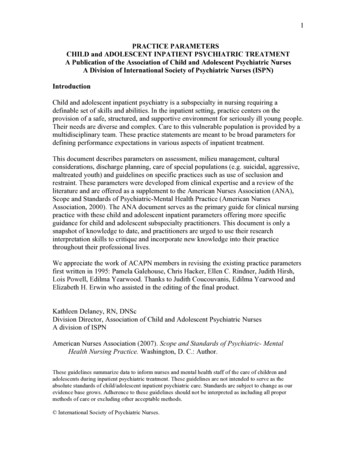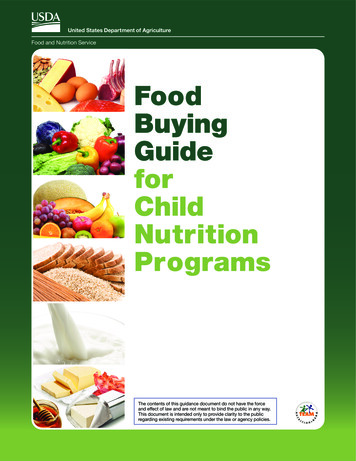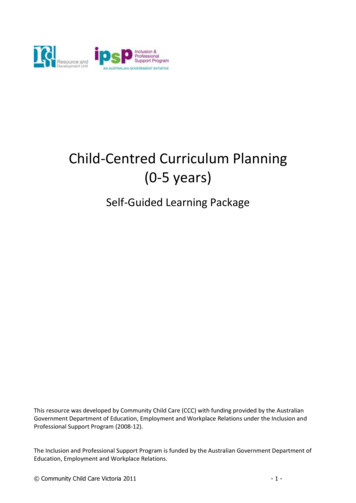
Transcription
Child-Centred Curriculum Planning(0-5 years)Self-Guided Learning PackageThis resource was developed by Community Child Care (CCC) with funding provided by the AustralianGovernment Department of Education, Employment and Workplace Relations under the Inclusion andProfessional Support Program (2008-12).The Inclusion and Professional Support Program is funded by the Australian Government Department ofEducation, Employment and Workplace Relations. Community Child Care Victoria 2011-1-
About Self-Guided Learning PackagesSelf-Guided Learning Packages can be completed in your own time and convenience and offer analternative to attending training sessions. This package aims to develop skills and knowledge that will bevaluable to you in providing quality education and care programs. Packages are often used for professionaldevelopment by staff teams, networks and other groups of children’s services professionals. You can workthrough the package with colleagues by reading the package together, discussing the information andcollaborating to complete the one assessment task.Gowrie Victoria Leadership and Learning Consultants are available to support you while working throughthe package. Feel free to phone or email if you require any assistance completing the tasks within thepackage. Phone 1800 103 670 (freecall) or (03) 9347 6388 or email psc@gowrievictoria.org.au Community Child Care Victoria 2011-2-
Child-Centred Curriculum Planning (0-5 years)You have chosen to complete the Child-Centred Curriculum Planning (0-5 years) package. The aim of thispackage is to provide you with an opportunity to learn about the value of child-centred curriculum and howit can be implemented in a range of children’s services.A child-centred curriculum offers children the opportunity to make choices about what, how and whomthey want to play. This approach enables children to initiate and direct their own play with the support ofinterested and responsive adults. In early childhood education curriculum, children construct their ownknowledge from their experiences and interactions with the world around them. Educators foster children’sgrowth and development by building on children’s interests, needs and strengths within a safe and caringenvironment.IntroductionValue of PlayIn order to provide a child-centred curriculum, you need to understand the importance of play.Learning through play:‘Play provides opportunities for children to learn as they discover, create, improvise and imagine. Whenchildren play with other children they create social groups, test out ideas, challenge each other’s thinkingand build new understandings. Play provides a supportive environment where children can ask questions,solve problems and engage in critical thinking. Play can expand children’s thinking and enhance their desireto know and to learn. In these ways play can promote positive dispositions towards learning. Children’simmersion in their play illustrates how play enables them to simply enjoy being’ (EYLF, 2009 p15).‘Early childhood educators take on many roles in play with children and use a range of strategies to supportlearning. They engage in sustained shared conversations with children to extend their thinking .They providea balance between child led, child initiated and educator supported learning. They create learningenvironments that encourage children to explore, solve problems, create and construct. Educators interactwith babies and children to build attachment. They use routines and play experiences to do this. They alsorecognise spontaneous teachable moments as they occur, and use them to build on children’s learning (EYLF,2009, p15).Play supports children’s sense of belonging, being and becoming. Play supports a child’s physical, social,emotional and intellectual development as it provides children with the opportunity to: Practise physical skills Release energy Develop positive social skills and behaviour Learn about themselves and others Build self esteem and confidence Learn and practise language Develop creativity, imagination and curiosity Pursue and develop their own interests Express their personality and uniqueness Explore materials, equipment and natural objects Develop problem solving skills Develop independence and autonomy Develop relationships and concepts Make connection between prior experiences and new learning. Ask questions Community Child Care Victoria 2011-3-
Holistic approaches to curriculum planning:‘Holistic approaches to teaching and learning recognise the connectedness of mind, body and spirit. Whenearly childhood educators take a holistic approach they pay attention to children’s physical, personal, social,emotional and spiritual wellbeing as well as cognitive aspect of learning. While educators may plan orassess with a focus on a particular outcome or component of learning, they see children’s learning asintegrated and interconnected’ (EYLF, 2009, p14).Self Help Question 1List any other benefits of play you have observedWhat is a Child-Centred Curriculum?A child-centred curriculum: Is planned and implemented with a focus on children learning through play Is based on children’s needs, interests, strengths, understandings and capacity. Reflects a range and variety of experiences to cater for children’s needs, interests, abilities Takes account of the need for children to pursue their own interests and play experiences Recognises the child’s voice, it captures the child’s ideas and intentions and recognises theirlearning strategies or learning goals. Is communicated appropriately to children, families and educators through written and verbalinformation Is sufficiently flexible to permit changes initiated by children and educators working together Reflects the interests and diversity of the children and the expertise of the educators Reflects the connections between children, families and communities and the importance ofreciprocal relationships and partnerships for learning. Values the cultural and social contexts of children and their families Community Child Care Victoria 2011-4-
Self Help Question 2Consider a curriculum, you have recently implemented. Write a brief summary of what occurred taking intoconsideration the points mentioned above.How did the curriculum reflect the interests of the children? List three points.Describe how the curriculum was communicated to the children and families.What could you have done differently based on the information listed above?Some approaches to Curriculum Planning that are not reflective of a child-centred curriculumThe egg carton curriculum - the use of novel or unusual art and craft activities, usually chosen because ofeducator’s interest, available materials or to impress parents. The emphasis is on the ‘end product’ ratherthan the processes or effort involved. Often the ‘products’ all look the same and there is little opportunityfor children to be creative or make choices about how they use the materials.Acceleration based on getting the child ready for the ‘next step’ rather than focusing on the current skillsand interests of each child. The provision of materials and experiences is usually determined by skillschildren will need in the future, rather than their existing skills and interests.Fill in the blanks or the ‘activity based’ model of planning where ‘one off’ experiences become the focus ofthe curriculum, and are used to ‘fill in the blanks’ on the planning format. Educators select materials andexperiences because they have not been used or implemented for a while, rather than chosen to meet theindividual needs and interests of the children.Themes - curriculum is based on a particular idea or concept to ‘hang’ planning on, such as seasons,festivals or popular culture. This approach often follows a predictable format year after year and does notallow for the fact that children may not be interested in the theme at that time. Adults usually imposethemes without consulting or collaborating with children. Community Child Care Victoria 2011-5-
Non- curriculum planning provides no guidelines for children’s needs, as educators believe the curriculumneeds to be flexible with lots of free play. This may lead to children’s needs, interests and strengths beingoverlooked as well as children and educators lacking direction.Behaviour based - the environment and experiences are chosen on the basis of maintaining control. Someexperiences may not be offered because of the inappropriate behaviour of a ‘few’ children or becauseeducators feel they will lose control of the group. This approach focuses attention on negative behaviourand disadvantages the majority of children.These approaches take very little account of children’s needs, interests and strengths as theadults largely define and direct the program. In order to provide a child-centred curriculum,educators need to consider the following;Strengths-Based curriculum approach:Rather than focus on deficits and what does not occur, a strengths-based approach to curriculum relies onthe positive resources and abilities that children and families have and uses these to enhance the wholeexperience of early childhood education and care.Strengths Based Planning DiagramA Child-Centred Approach to CurriculumA child-centred approach: Is a curriculum designed to build on the unique needs, interests, disposition and strengths of eachchild Is where educators constantly notice individual and groups of children and use this information torecognise and respond with a relevant curriculum Community Child Care Victoria 2011-6-
Is where the environment and experiences provided are matched to children’s developing skills andinterestsProvides opportunities for choice and decision-makingEnables children to initiate and direct their own playConsists of experiences that are mainly open-ended, enabling children to develop creativity andproblem solving skillsIs where the educators structure the environment to encourage positive social interactionsamongst children and adultsUses many opportunities to develop self help skills, independence and responsibilityIs inclusive and responsive to diversitySelf Help Question 3List two approaches and define what this looks like in practice?Observing/Noticing childrenIn order to plan and implement a child-centred curriculum, educators need to gather and analyseinformation about what children know, can do and understand, their interests, skills and strengths. This isan integral part of the planning process, because it provides information that is used for making decisionsabout how educators respond to each child to build on their unique strengths, interests and knowledge andto support them in their learning and development.As educators working alongside children a useful tool isNOTICING, RECOGNISING AND RESPONDING Noticing - What is happening? What seems important about this? ‘Noticing is more than observing.It involves deep listening to the many ways children express their ideas and intentions. Recognising - What do educators understand from what they see – what learning is occurring?Recognising is the deliberate, thoughtful process of making meaning of what has been noticed. Respond - How do we respond? What next? Responding is deciding how to act intentionally toprogress children’s learning.’Educators use a variety of strategies to collect, document, organise, synthesise and interpret theinformation that they gather to assess children’s learning. They search for appropriate ways to collect richand meaningful information that depicts children’s learning in context, describes their progress andidentifies their strengths, skills and understandings.’ (EYLF, 2009, p17)Some methods for gathering information are: Anecdotes and written observations Jottings, stories and pictorial journaling in daily diaries Audio/video recordings Photos Samples of children’s work (e.g. Children’s drawings, photos of children’s constructions, transcribedstories, conversations etc) Community Child Care Victoria 2011-7-
Running recordsNarratives (e.g. learning stories)Gathering information about children can be used in a number of ways, it can help educators to:1.2.3.4.5.6.7.8.Plan effectively for children’s current and future learningEstablish a broad picture about the background of each childIdentify interests and skills of individual and groups of childrenUnderstand children’s behaviour and patterns of playIdentify how children use the environment and participate in experiencesConsider ways to extend and build upon children’s play and interestsUnderstand how children interact with other children and educators.Assess the effectiveness of their planningIt is the educators’ responsibility to ensure that they record and share information that demonstrateschildren are valued and respected as strong, competent and capable learners. This information enableseducators to plan and create a rich environment to spark children’s curiosity and desire to explore,experiment and create and ensure a range of choices are made available to children both indoors andoutdoors. The use of innovative methods to document children’s play and learning can also providemeaningful ways to connect with children and their families.Self Help Question 4List the methods you currently use to observe and gather information about childrenOther than observing children directly, how can you gather valuable information and insights into children’slearning through a variety of other sources?Consider a recent observation of a child or a group of children you have done. Describe what you noticed(what was happening)?Describe what you recognised (what learning was occurring)? Community Child Care Victoria 2011-8-
Describe how you responded (what next)?How could you improve the way you gather and document information to provide a more child-centredcurriculum?Selecting experiences and planning learning environments to support a child-centredcurriculumLearning environments’Learning environments are welcoming spaces when they reflect and enrich the lives and identities ofchildren and families participating in the setting and respond to their interests and needs. Environmentsthat support learning are vibrant and flexible spaces that are responsive to the interests and abilities of eachchild. They cater for different learning capacities and learning styles and invite children and families tocontribute ideas, interests and questions. Outdoor learning spaces are a feature of Australian learningenvironments. They offer a vast array of possibilities not available indoors. Play spaces in naturalenvironments include plants, trees, edible gardens, sand, rocks, mud, water and other elements fromnature. These spaces invite open-ended interactions, spontaneity, risk-taking, exploration, discovery andconnection with nature. They foster an appreciation of the natural environment, develop environmentalawareness and provide a platform for ongoing environmental education’ (EYLF, 2009, pp15-16).Indoor and outdoor environments should support all aspects of children’s learning and invite conversationsbetween children, early childhood educators, families and the broader community (EYLF, 2009, p16). Theyshould promote opportunities for sustained shared thinking and collaborative learning. ‘Materials enhancelearning when they reflect what is natural and familiar and also introduce novelty to provoke interest andmore complex and increasingly abstract thinking. For example, digital technologies can enable children toaccess global connections and resources, and encourage new ways of thinking. Environments and resourcescan also highlight our responsibilities for a sustainable future and promote children’s understanding abouttheir responsibility to care for the environment. They can foster hope, wonder and knowledge about thenatural world’ (EYLF, 2009, p16).‘Educators can encourage children and families to contribute ideas, interests and questions to the learningenvironment. They can support engagement by allowing time for meaningful interactions, by providing arange of opportunities for individual and shared experiences, and by finding opportunities for children to gointo and contribute to their local community’ (EYLF, 2009, p16).Selecting experiences and planning the environment is a process that should involve children, educatorsand families. The right balance of experiences will ensure children find the environment and program Community Child Care Victoria 2011-9-
inviting and engaging. It is imperative that environments be organised in such a way as to empower andenable children to be in control of their own learning. An environment with clear boundaries that is richwith open ended experiences and allows children to actively and independently engage in activities lendsitself to positive interactions.Some reflective questions to consider when planning the environment:1.2.3.4.5.6.What are the interests of the children?Does this environment enable children to discover, create, improvise and imagine?Does this environment encourage children to explore and solve problems?What are the children looking for each day and at different times of the day?Are children offered opportunities to play by themselves, in small and large groups?Are children offered opportunities to learn new and interesting skills in a safe and supportiveenvironment?7. Can children choose from a range of materials and equipment, and initiate their own play?8. Are children offered the following range of balanced experiences within the curriculum?o Art and craftso Physically active playo Science, maths and technologyo Language and literacy experienceso Construction and gameso Dramatic and imaginative playo Music and movemento Sensory play (water play, sand play)o Nature and environmental experiences‘In a supportive active learning environment, children who are confident and involved learners areincreasingly able to take responsibility for their own learning; personal regulation and contribution to thesocial environment, Connections and continuity between learning’s experiences in different settings makelearning more meaningful and increase children’s feelings of belonging.’ Outcome 4 – Children areconfident and involved learners (EYLF, 2009, p33).When planning learning environments, reflect on the EYLF Outcomes 1 to 5, on pages 19 to 44, andconsider how the environments created and planned support children’s learning.Self Help Question 5Identify and list some of materials or equipment that could be included in each of the interest areas listedabove, e.g. Art and crafts may include assorted paper, drawing materials, paint, scissors, glue and tape,boxes, cloth scraps etc.Physically active play:Science, maths and technology: Community Child Care Victoria 2011- 10 -
Language and literacy experiences:Construction and games:Dramatic and imaginative play:Music and movement:Sensory play:Nature and environmental experiences:A high quality environment offers children a balanced range of materials and experiences that are openended, flexible and based on children’s interests. The environment is rich and responsive, and allows Community Child Care Victoria 2011- 11 -
children to have choices and make decisions about the program. Educators create play spaces that enablechildren to actively explore their interests, interact with others and develop real skills.Implementing experiencesChildren should always be actively involved in initiating and selecting experiences for the curriculum.Experiences should be planned and implemented with these considerations in mind:1. Is this experience based on the children’s needs and interests? Have children been actively involvedin the planning?2. Is the focus on the process, rather than the product?3. When and how should the experience be introduced?4. What age range/developmental level is the experience suitable for? How can it be modified orextended to suit all interests and skill levels?5. What space, materials and equipment are available and needed for this experience?6. How will I present the experience to encourage children’s involvement and engagement?7. What limits are appropriate for this experience?8. Is the experience open-ended, flexible and does it provide children with choices?9. How will educators be involved in this experience?10. How can I extend or modify the experience?11. How can I document children’s interactions and learning during this experience?12. How can I assess this experience?Self Help Question 6Consider an experience you have recently implemented with a group of children. Write a summary of theexperience, taking into account the questions listed above.The adult role in a child-centred curriculumResearch has shown that children’s play becomes richer and more complex when adults support children intheir play (Educators’ Guide to the Early Years Learning and Development Framework for Australia, 2010). Community Child Care Victoria 2011- 12 -
Although educators have an important role in facilitating and supporting play, it is essential for children tobe involved in play experiences that they have chosen. Early childhood educators take on many roles in playwith children and use a range of strategies to support learning.Educators: engage in sustained shared conversations with children to extend their thinking. provide a balance between child led, child initiated and educator supported learning. create learning environments that encourage children to explore, solve problems, create andconstruct. interact with infants and children to build attachment utilising routine times and play experiences todo this. recognise spontaneous teachable moments as they occur, and use them to build on children’slearning. support young children through role modeling to promote positive ways to relate to others. ‘actively support the inclusion of all children in play, help children to recognise when play is unfairand offer constructive ways to build a caring, fair and inclusive learning community.’(EYLF, 2009, p15).Educators need to plan and resource a challenging environment where they can support and extendchildren’s play. This can be achieved by sensitive observation and appropriate intervention, being awarethat it is sometimes important not to interrupt when children are deeply involved in their learning thoughplay.Allowing children to be spontaneous and to direct their own play experiences and then sometimes joiningthem, but on their terms (not taking over and directing), requires experience, along with a deep trust in thechildren themselves and in one’s own knowledge base. That knowledge base is a mixture of personal andprofessional life experience, knowledge from training/study, mentors, reading books, sharing ideas withcolleagues etc. It is also informed from learning from the children and families.’Supporting children’s play is more active than simply saying you believe that it is important. Whenchildren’s play culture is taken seriously, the conditions which make it flourish are carefully created.Children’s play culture does not just happen naturally. Play needs time and space. It needs mental andmaterial stimulation to be offered in abundance. Creating a rich play environment means creating goodlearning environments for children’ (Kalliala, 2006, p139).Some strategies that Educators can use to support children’s play: Allow children to choose their own play experiences. Provide a variety of interesting materials,equipment and props and allow children to decide which ones to explore and use during play.Mediating to help children solve a problem while allowing them to negotiate their own solutions.Encourage children to solve problems and think divergently.Let children determine how long they will play. Children need unhurried time to play. Avoidpushing children to continue with activities they have lost interest in or interrupting them beforethey have really finished a task, project or play experience.Provide experiences and materials that challenge various skill levels. This ensures the child will notbecome easily bored or frustrated with an experience. Add more complex materials as childrenbecome more capable and want to explore their interests further.Focus on the process, rather than the end product. Encourage children’s efforts and avoidcomparing children or doing tasks for them. Avoid providing examples of finished products orexpecting children to create the same ’product’.Give children the freedom to be messy. Show children it is okay to be involved in messy play andencourage parents to be aware of the value of messy play.Participate when needed, notice when not. Community Child Care Victoria 2011- 13 -
Be sensitive and responsive to children’s play. Your interest, enthusiasm and encouragement willreinforce children’s self-motivation and pride in their play.Arrange the room to encourage children to self regulate their behaviour. Clear boundaries, trafficpatterns and self contained experiences will all assist children to do this.Help children to establish and maintain limits during play. Provide appropriate and consistentguidance. This will ensure that children play in a positive social environment that fosterscooperation and collaboration.Acknowledge the child as capable and resourcefulPromote the value of play and the child’s right to playFurther reading: Early Years Learning Framework – Principles and Practices, 2009, p12-18 Community Child Care Victoria 2011- 14 -
Self Help Question 7Consider a recent experience where you have supported children’s play. Write a brief summary of theexperience and give five examples of how you were supportive of children’s play?Materials and equipmentWhen selecting materials and equipment, educators need to consider the following criteria: Benefits - what are the benefits for the child?Variety - is there sufficient variety to meet the needs and interests of all children?Safety - are the materials safe for the children who are using them? Consider children’s skills andabilities.Sufficient quantity - is there enough for all children to participate freely without always having toshare or wait for a turn?Durability - will the materials last? Can they be used extensively by many children over a longperiod of time?Accessibility - can children access materials independently and easily?Independent use - can children use materials with ease and without the need for constant adultassistance?Aesthetics - are the materials and experiences set up and offered to children in an appealing andinteresting way?Authenticity - do the materials offer children opportunities to use ‘real’ tools and equipment?Cost/value - do the materials provide value for money? Consider the use of more cost effectivematerials such as recycled, junk and natural materials.Materials and equipment should offer children a balance of: sy/non-messysimple/complex Community Child Care Victoria 2011- 15 -
individual/groupindoor/outdoor‘The degree of creativity and the possibility of discovery are directly proportional to the number and kind ofmaterials in it’ (Greenman, 1998, p107).Natural/Recycled MaterialsCommercially produced toys and equipment are often made from artificial materials such as plastic. Adultsoften choose these toys because they are durable, brightly coloured and easily cleaned. Children who onlyplay with these toys are missing out on important sensory experiences and learning opportunities. Sensorystimulation derived from interacting with natural materials allows children to learn with and engage all oftheir senses. These senses include seeing, hearing, touching and smelling.The use of recycled and natural materials can further enhance a child-centred curriculum as children canuse the materials in many different ways. Children are free to explore the materials without theexpectation of how they should be used.The provision of recycled and natural materials can provide important learning opportunities for children. Materials can be used in variety of ways, limited only by imaginationChildren enjoy arranging and rearranging material from the ’real‘ worldMaterials can be used in conjunction with other equipment to provide more challenging andinteresting experiencesWhen combinations of materials are changed frequently, exploration and discovery are stimulatedCo-operation and sharing of ideas is often enhanced when children are free to arrange and explorematerials togetherDramatic play is enhanced, as children take on a role relevant to the environment they have madeWhen used carefully, the provision of these materials helps to maintain and expand children’sinterests and ideasChildren can learn about the importance of recycling and caring for the natural environment.Will assist children to develop an increased understanding of the interdependence between land,people, plants and animals.Play spaces in natural environments foster an appreciation of the natural environment, developenvironmental awareness and provide a platform for ongoing environmental education.Children of all ages need to experience the natural world: To begin to feel a sense of belonging and responsibility for the world of living things, plants andanimalsAs our awareness of environmental issues increases so does the value of environmental curriculumfor children. Providing children with knowledge, skills and attitudes on environmental issues willassist them to become environmentally responsible. Participating in environmentally sustainableactivities will provide opportunities for children to connect with and to embrace the natural world.You can begin to develop a collection of natural materials to use with children. Here are a few suggestions: Cloths and fabrics: many fabrics are made from plant or animal fibres – cotton, linen, silk. You willfin
knowledge from their experiences and interactions with the world around them. Educators foster children’s growth and development by building on children’s interests, needs and strengths within a safe and caring environment. Introduction Value of Play In order to provide a child-centred c
